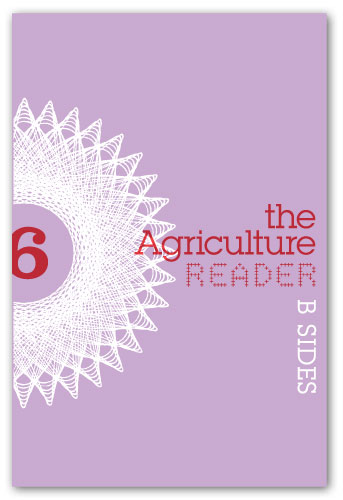
It was a cold spring morning when I arrived in Carroll Gardens to meet with Justin Taylor at a coffee shop. I was there to talk with him about The Agriculture Reader, the journal he co-edits with Jeremy Schmall. More broadly, I was also curious to see how the publication’s focus on poetry and esoteric fiction dovetailed with Taylor’s own concerns as an author.
Taylor had a number of past issues of The Agriculture Reader with him, and I snapped a few photos, documenting the changing look and feel of the publication over the years. What follows is an edited version of our conversation.
The launch party for The Agriculture Reader‘s sixth issue will take place tonight at 7 pm at Berl’s Poetry Shop, and will feature Greg Purcell, Leopoldine Core, Polly Bresnick, and Alec Niedenthal. We reprinted two poems from that issue earlier this month.
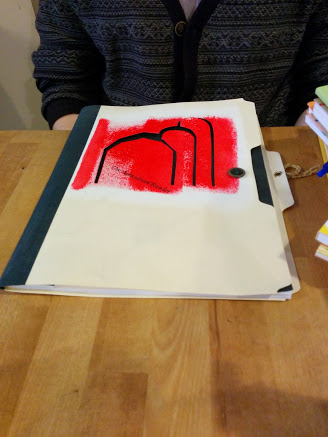
This is issue number one. This was printed in an edition of… Well, it was numbered [up to] 150. I doubt one hundred of them were ever made. It was printed, literally, on New School computers, our second year of grad school, and it came with this CD. We had to cut all of this by hand. It took forever. And this was still when it was really just Jeremy’s… It was his project, his and his girlfriend at the time. The Booklyn Artists Alliance helped him. I was sort of around; I had a poem or a story in here.
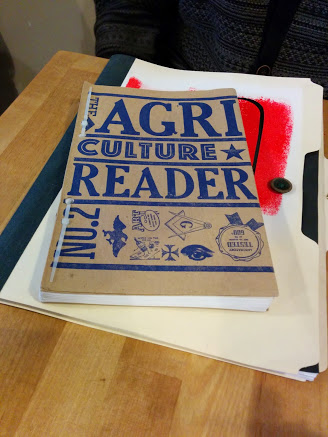
And then, number two was when it really came together. Mark Wagner, who was the book artist, and Amy Mees, who was the designer, were still in Brooklyn at that point. Mark kind of took over the physical production. I think this is, to date, the most ambitious issue we did. It’s printed on uncut French pagelets, and these are–I don’t know if this is grocery bag paper, or–these are screenprints on the cover. We had a paper drill at the time, and so it’s drilled, then bound with these zip-ties, and we used pennies. Early on, we had a CD.
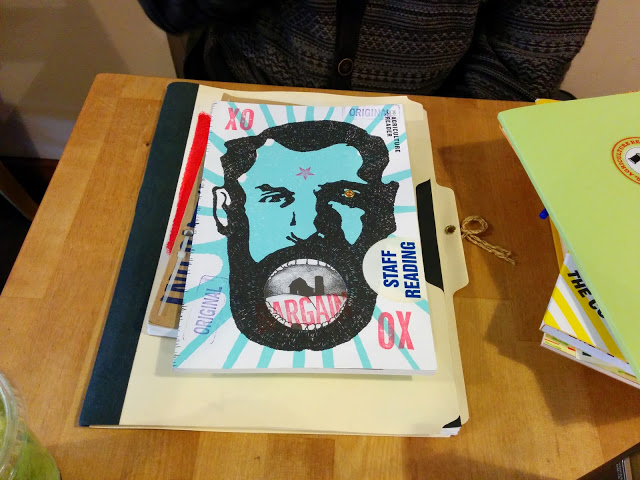
This is issue number three; this is where we standardized the format. This is also the first issue where I served as co-editor. At this point, Mark and Amy had left Brooklyn, and we went with them. They were toying with the idea of becoming a small press, which they still kind of are. We did this issue, and around that same time, we did another book of Jeremy’s, which I didn’t bring, and then this little guy.
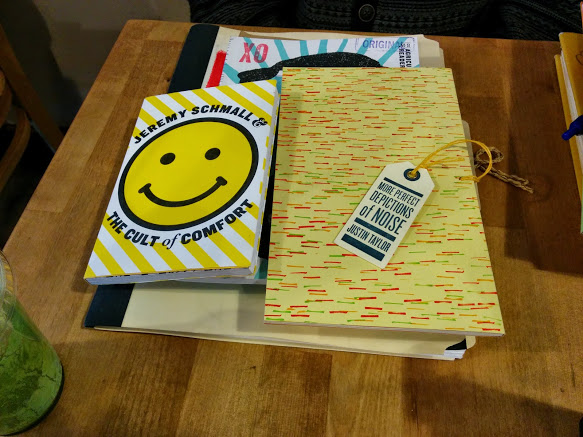
This is a lost classic; this is my poetry collection. Which I don’t typically talk about or show anyone, or do anything with.
The funny thing is, I was planning to ask about that. I know you as a writer of prose and as a critic, but obviously, you care deeply about poetry – you edit a poetry journal, I’ve seen you speak about poems that have affected you.
Poetry’s really important to me. A lot of The Gospel of Anarchy is about poetry. It’s not a clue in the sense that it’s a mystery, but… The poems that appear in that novel are the only things that can solve the otherwise indeterminate notion of the supernatural in that book. And in some ways, that book is an argument about poetry.
When I was younger, I wrote a lot of different kinds of stuff. Through grad school, I took poetry classes; I was also writing it, and publishing it. Over the years, I realized that there had to be a certain economy of effort, and that someone couldn’t or shouldn’t — couldn’t more than shouldn’t, perhaps–do everything. I decided that the world didn’t need my mediocre poetry, and attempts to inflict it on it. On a personal level, I realized that a lot of the reason that I was still trying to publish poetry was that I didn’t understand how else to be involved in that community. So editing the magazine has been a good way for me to stay involved in that world. To read a lot of poetry and champion it and insist on its importance, without insisting on myself as a practitioner. Which is what the poetry world needs–which is what all of literature needs–people who affirm the value of being readers and supporters without wanting to be published.
This came about because Mark and Amy were getting X-Ing Books off the ground. At the time, we thought that we were going to be a small publishing house, and solicit work. We thought it made sense to self-publish first, so we didn’t screw up anybody else’s manuscript. So basically, I edited Jeremy’s book and he edited mine, and we put the two of them out.
The main lesson we really learned from it was that we were not really equipped to be small press poetry publishers, the way we’d thought. Jeremy’s book has had a really interesting life: it pops up here and there. Whenever someone needs this book, it appears to them somehow. This book, I was doing a lot of other things; I didn’t have the wherewithal or the attention to promote it in any kind of way. And it became, for me, the capstone of my career as a poet, as it were. It’s the last will and testament of me as a poetry writer, which is fine. X-Ing has done some other books: they did one other of Jeremy’s; they did some interesting art books. They tend to do much more limited edition, and some of them are very expensive. They did one book with this guy who does these drawings, Scott Teplin. That stuff’s on the website. That’s really Mark and Amy’s stuff.
I would say the big thing about this was that we realized that we needed to commit to actually getting the book offset printed, but wanted to keep it feeling very DIY and hand-done. This issue was done in an edition of 500; the cover was again screen-printed, and all of these little finishing touches were done by hand. We agreed to standardize the physical form, but keep it new.
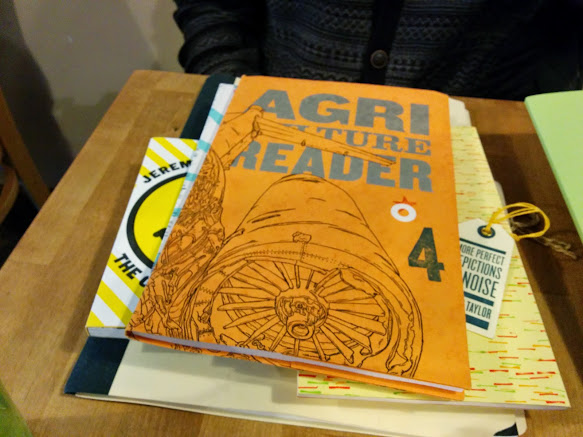
Number four: this was two passes through the screenprinter. I think this is the only one we’ve done with a removable cover. It has the nice little divot. And five had the minimalism; it was super-minimalist. The cover was totally hand-done, but only in the sense that there is no cover. This is actually a clear sticker, and that’s a piece of paper. They’re stuck on there.
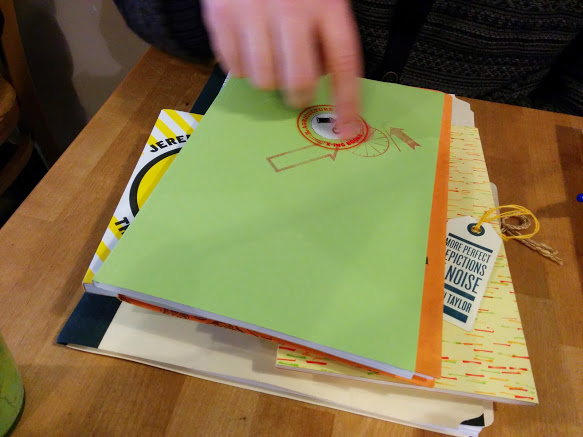
This comes with these little occasion cards that Mark and Amy made. There’s a “Thank you,” there’s a “Sorry,” and there’s a “Fuck you.” Basically, that’s it; that’s the history of the thing. Issue three is where a lot of things got solidified. Mark and Amy took over as the design and art team; Jeremy and I became co-editors. The format… The other big breakthrough for three was… All of the issues had had art. Jeremy was soliciting a piece here and there and figuring out what he could reproduce. Issue three was where we decided to get one artist who would illustrate the whole issue. This was this guy Joey Parlett, and we’ve always done that since then. This was Scott Teplin; this was Amy Mees herself. She did all the art. For number six, because we did the dos-à–dos for the first time, we had one artist for each side.
In terms of the sixth issue, when did you decide that you were going to do that?
We did not realize that. As a format, it was probably one of the last things we figured out. I’ll say this: one thing that we’ve wanted to do for a long time is to publish a full manuscript inside an issue, or possibly even as an issue. We had talked for years about doing a one- or two-author issue. We didn’t quite do that, but we did want to publish a complete…something. In general, we’ve been moving towards featuring more work from fewer writers. Earlier tables of contents are in that more traditional, one or two pieces, poems or flash fiction; there’s thirty people in it.
Over the years, as we’ve seen what we’re interested in, we like working with the same people over and over. We like giving space to the same people for things that might have a difficult time finding homes elsewhere. We’ve become really into long poems, when we can find one.
With this, we solicited work from Greg Purcell. He’d been in number five, and we liked his stuff. As we typically do when we solicit people, we said, “Send as much as you want; send anything you want, and we’ll go through it all and pick.” He sent us about twenty pages of stuff, and Jeremy and I–the way we read is we sit and read it out loud to each other. We were reading the whole thing out loud, and we said, “We like the whole damn thing; how are we going to pick five pages out of this?” We tried, and we just couldn’t. I finally said to him, “What if we just ask Greg for another batch?” He sent us another ten or fifteen; I think we took all of that, or pretty close to it. I just said, “Will you put a title on it, and we’ll call it a book?” We’d talked about doing it in the McSweeney’s style, where the issue consists of separate books. I don’t know. In the end, the dos-à-dos seemed to make sense. In part because it became the main physical feature of this issue, which we otherwise hadn’t developed yet.
When did you arrive on “The B-Sides” as the title for the other half of it?
I think it just suggested itself after Greg settled on The New Music as the title of his manuscript. In this case, function followed form. We had the manuscript; Greg titled it; then we decided to do a dos-à-dos. It felt very natural, in trying to describe it to people, like when we were in production, to say to Mark, “Well, the a-side.” I think it made it a courtesy: when you have a guy anchoring it with a book, you give him the a-side. And b-sides suggested itself. Not to suggest that that work is secondary. It’s really amazing, and a bunch of really mind-blowing stuff.
The balance in here is much more in the direction of poetry, although there is some fiction. Has that always been the case with the journal, or has it shifted somewhat over the years?
It’s definitely shifted. The first issue was almost entirely poetry, except for two pieces, one of which was a flash fiction of mine and the other was a flash fiction, prose poem thing by a woman named Danielle Benveniste. In the second issue, there was more fiction, but again, it was more flash stuff. I don’t think it was until issue three, or maybe even issue four, where we published something that was a full-length short story.
Every issue has tried to expand the boundaries of what we do. More fiction, more longer poems, more nonfiction, which we’ve been working on over the years, trying to do more of that. One thing we did in issue three was, we did a retrospective on a poet named Tony Towle. We picked about a dozen poems out of his collected [works], and had a prose appreciation written by a friend of ours. That gave us an interest in the idea of republishing. We tried to republish work by a living author who had kind of fallen off the radar. In number four, it was a long poem by a guy named Douglas Crase, a beautiful poem called “The Revisionist,” from his first and only collection.
Doing the Tony Towle thing made us think that we should republish lesser-known work by living writers. Choosing Crase for the second installment of that said, “Okay; we’re interested in the longer poems.” And then, in issue five, it was Paul Violi, although that was complicated a little bit by the fact that he died on us. He was a good supporter of the magazine; he was a teacher of ours in grad school, and we really loved him. It had been intended to be in that tradition, and it wound up adopting an elegiac quality that it hadn’t been meant to have.
We also had an interest, at a certain point, in reprinting material out of the public domain. In issue five, we did a section of G.K. Chesterton’s nonfiction diary of visiting New York.
Oh, wow. I don’t think I knew that that existed.
He wrote a book that was modeled on Dickens’s American Notes. He goes around New York City and America in the…1910s? 20s? He wrote this wonderful paragraph about standing in Times Square, and what he viewed as the curiously American affectation of billboard advertising. We were just…in love with it.
The short story in here, about the family that goes to track down Jennifer Lawrence — I feel like the fact that it’s fiction isn’t the greatest contrast to the poetry elsewhere in the issue; it’s that it’s so dense. It’s obsessively written, about characters who are obsessives.
Alec [Niedenthal] is an amazing young writer, and such a smart guy, and such a wonk, when he getrs onto something to be wonkish about. We met him online. He emailed us a submission when he was, probably, eighteen or nineteen. We didn’t take it, but we really liked it. He and I struck up an email correspondence. That must have been around issue three, because he has the lead piece in issue four.
When I met him, he was the age of a lot of my students. But he’s so smart, and so overwhelming. And that was a long time ago; he finished his undergrad and got into Brown, and now he’s in the first year of the Brown program.
You also have some work in here in translation. Andri Snaer Magnason–how did you first encounter him?
Me and Andri met because he read at Housing Works. He’s a novelist; he has this book, Lovestar, that Seven Stories did a year or so ago. I’ve been on a huge Iceland kick for the past few years anyway: traveling there, writing about it. As I was learning a little more about him, we heard that he had written this book of poems in Iceland in the 90s called Bonus Poetry. Which is about the one national Icelandic grocery store chain — their Winn-Dixie, basically. He’d written this book of satirical poems re-imagining a trip to Bonus as Dante’s Inferno.
Because Iceland is amazing, Bonus loved it. And they published it. And they stocked it, and it was a national bestseller because it was in the checkout aisles for years and years and years. It has never been done fully in English. Pieces of it have been. And we inquired to him about the prospect of doing the first English translation of the Bonus poems. For various reasons, it didn’t work out. But we found this other stuff of his, and were really interested in that. Some of the Bonus stuff is in English on his website, and he had said, “You can publish that if you want.” But I didn’t want to publish stuff that had already been on the website. We got these prose poems…
I’ve say, over the years, we’ve tried to do more translation in general. It’s hard, because Jeremy and I are both monolingual. It requires us to not only believe in the work, but also to have perfect faith in the source that it’s coming from. If you’re conscious that something isn’t your strong suit, you become concerned: do I best serve the literary world by doing something I’m bad at? The whole time, you think, “I could stand to improve.”
The fifth issue had the most translation ever. One issue, we had work from this Hebrew poet, a couple of little things. In this issue, we have the Icelandic stuff. Ian Dreiblatt, who’s a Russian translator — his Mandelstam Variations, as he calls them… I asked him to explain that project. I don’t know how much of it is translation, paraphrase, adaptation, homage — he declined to clarify, which seemed like his right. After you’ve translated most of Melville House’s Russian list, I feel like you can trust him.
And then there’s the Polly Bresnick.
I found that especially fascinating to take in.
That’s a super-cool project. It’s a mistranslation, or a “visual translation,” as she calls it. She doesn’t read ancient Greek. She looks at the ancient Greek and imagines what English words it looks like, and writes the poems. And, I think, attempts to achieve a kind of consistency, where if she translates a word one way one time, she does it again. But obviously, when you’re looking at a word that is totally opaque to you, you’re not always going to keep those visual cues. I think we’ll continue to push at those boundaries.
So you basically have it set up where it’s one issue per year, at this point?
We try to do an issue per year. There were about two years between issues five and six. I was working on my stuff, and Jeremy had been in Detroit, and Mark and Amy moved to Pennsylvania and had a baby. Life got in the way, in a variety of ways. The thing is, we’re so small that we feel like we’re very good at being where we’re supposed to be. We don’t take subscriptions. We kind of take submissions, but not really. The entire responsibility of the thing is self-generated. We’ll only do it when it feels really necessary to do it.
One a year is the goal. But I will say: every time we put an issue out, Jeremy and I say, we’ll start from the premise that that was the last issue, and we quit. If we didn’t feel like we’d put everything we had into the issue we just did, it wouldn’t be worth doing. If we put it out and say, “That would be a great note to end on,” and then say, “What’s the argument against quitting?” And in the course of talking ourselves out of quitting, we start to shape the next issue.
Do you have a sense of what’s on the horizon, or has that discussion not yet happened?
I think that discussion has just barely begun to happen. I would say, I think there’s a feeling that for us to do a seventh issue, we’d really want to push. We’d want to make another great leap forward. I think the dos-à-dos and doing the full manuscript felt really right, and I can see continuing that gesture in some sort of way, whether that means publishing a novella or another poetry collection. I think we want to do more with prose. And also, maybe, with things that break down that idiotic distinction between categories of things. Poetry and prose, but also fiction and nonfiction.
We published a very small piece of Eileen Myles’s novel Inferno in issue three or four, and at the time, she was still calling it a memoir. So to us, at the time, it meant that we had published our first piece of nonfiction. Thinking about how the status of her book changed on its path to publication, and wondering how that does or doesn’t change the status of the piece of it that I published.
We were talking about Teju Cole before. In his novel, which is a novel, he brings a lot of nonfiction to bear to narrow that line to a terrifying… Also, Elissa Gabbert. Her book The Self Unstable; I know it came out little while ago, but I bought it this year at AWP, and thought it was a great book. That Jenny Offill novel that just came out — it’s fiction, it’s kind of a collection of fragments, it’s kind of close to prose poetry at certain points. I’m interested in all of that.
There’s also Kyle Minor’s new story collection, where some of the pieces were originally published as essays.
I think the main thing is to stake out some ground that feels like your own, that justifies your being there. One thing I see a lot in the poetry world. not to name any names, are so many journals that look totally interchangeable. They have bad art on the cover; they’re ungainly, they’re hard to read. And any ten of them… It’s the same university journal, over and over again. It’s got the same people in it. And if you took the master files and distributed them over ten universities, there would be no difference. We just don’t want to do that. One of the advantages of being so small is that we have that kind of agility. This magazine only has to do two things: not lose us more money in a given year than we can afford to lose, and be interesting enough that we feel justified in producing it. And that’s it. They sound like low standards, but I think they’re actually really high standards.
Do you think being involved with The Agriculture Reader as an editor has affected you as a writer, at all?
Yes, in a couple of ways. I would say that the main way that it’s affected me as a writer is what I said before: it freed me, in a very real way, from the less successful parts of my own writing practice. It taught me another way to stay involved in a community I was interested in. And it reminded me of the value of championing other people’s work. Being a writer–the writing part of it is so strange, because you spend all this time alone, and you’re wrestling with yourself. When something actually comes out, then you have to go into a weird self-promotional mode, and there’s a weird, paradoxical, stressful rhetoric around that.
Editing the magazine is very liberating. It exposes you to great literature in the same way that any kind of exciting reading does, and it puts you in a position to be an advocate for things that you believe in in a kind of selfless way. Selfish, in that it’s my magazine. But: I think Greg Purcell is amazing. I wish he had written and published ten books of poems, and they were all on the top of SPD, and whatever. It’s not for me to say why that has or hasn’t happened. I have no idea how much work he has attempted to put out in the world, or not. All I know is that the physical document, his book, The New Music–it’s incredible. It’s the kind of book that, if I found it in the store, I would want to read. And it didn’t exist. We had to make it. And I get all of the readerly pleasure, and can share in the credit for bringing it into the world. It seems like a really good deal.
Follow Vol. 1 Brooklyn on Twitter, Facebook, Google +, our Tumblr, and sign up for our mailing list.
